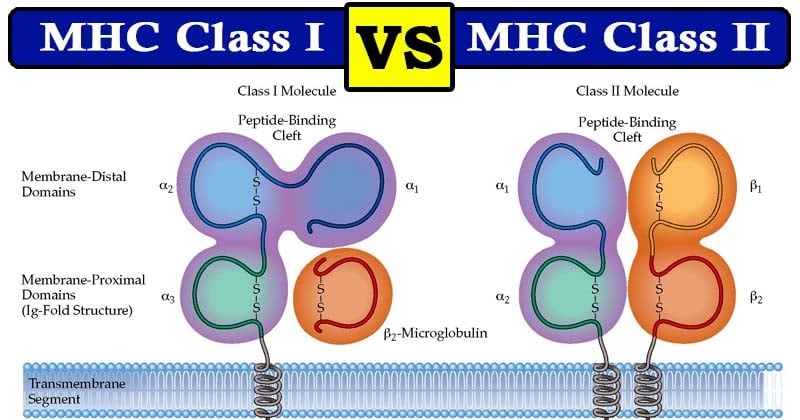Interesting Science Videos
MHC Class I and Class II differences (mhc i vs mhc ii)

The major differences are:
|
S.N. |
Characteristics | MHC-I molecule |
MHC -II molecule |
| 1. | Distribution | Present on almost all nucleated cells including platelets. | Have a restricted tissue distribution and are chiefly found on macrophages, dendritic cells, B cells, and other antigen-presenting cells only. |
| 2. | Encoding genes | MHC class I proteins are encoded by the HLA-A, HLA-B, and HLA-C genes. | MHC Class II proteins are encoded by the genes of the HLA-D region. |
| 3. | Nature of antigen presented | Antigens presented by MHC class I molecules are of endogenous origin. | Antigens presented by MHC class II molecules are derived from extracellular proteins. |
| 4. | Antigen | Cytosolic proteins; they sample peptides generated within the cell or those that may enter cytosol from phagosomes. | Class II molecules sample peptides outside the cell such as lysosomal proteins mostly internalized from extracellular environment. |
| 5. | Enzymes involved in peptide generation | Cytosolic proteasome | Endosomal and lysosomal proteases |
| 6. | Peptide loading of MHC | Endoplasmic reticulum | Specialized vesicular compartment |
| 7. | Peptide-loading complex | Includes the ER transporter associated with antigen processing (TAP1/2), tapasin, the oxidoreductase ERp57, and the chaperone protein calreticulin. | Chaperones in ER; invariant chain in ER, Golgi and MHC Class II compartment/Class II vesicle |
| 8. | Recognizing co-receptor | They are recognized by CD8 co-receptors through the MHC Class I β2 subunit. | They are recognized by CD4 co-receptors through β1 and β2 subunits. |
| 9. | Receptor T cell | Present antigens to CD8+ T cells. | Present antigens to CD4+ T cells. |
| 10. | Structure | MHC class I molecules consist of one membrane-spanning α chain produced by MHC genes, and one β chain produced by the β2-microglobulin gene. | MHC class II molecules consist of two membrane-spanning chains, α and β both produced by MHC genes. |
| 11. | Building amino acids | Possess 8-10 amino acids. | Possess 13-18 amino acids. |
| 12. | Peptide binding domains | α1 and α2 are peptide binding domains. | α1 and β1 are peptide binding domains. |
| 13. | Invariant chain | Has no invariant chain. | Has an invariant chain. |
| 14. | Functional effect | Presence of abundant antigens target cell for destruction. | Presences of foreign antigens induce antibody production. |
| 15. | Detection Method | Serology | Serology and mixed lymphocyte reaction |
References
- Brooks, G. F., Jawetz, E., Melnick, J. L., & Adelberg, E. A. (2010). Jawetz, Melnick, & Adelberg’s Medical Microbiology. New York: McGraw Hill Medical.
- Chelbi, S., Dang, A., & Guarda, G. (2017). Emerging Major Histocompatibility Complex Class I -Realted Functions of NLRC5. Advances in Immunology , 133, 89-119.
- https://microbeonline.com/difference-mhc-class-mhc-class-ii-proteins/
- https://www.slideshare.net/petermassawe1/similarities-between-class-i-and-class-ii
